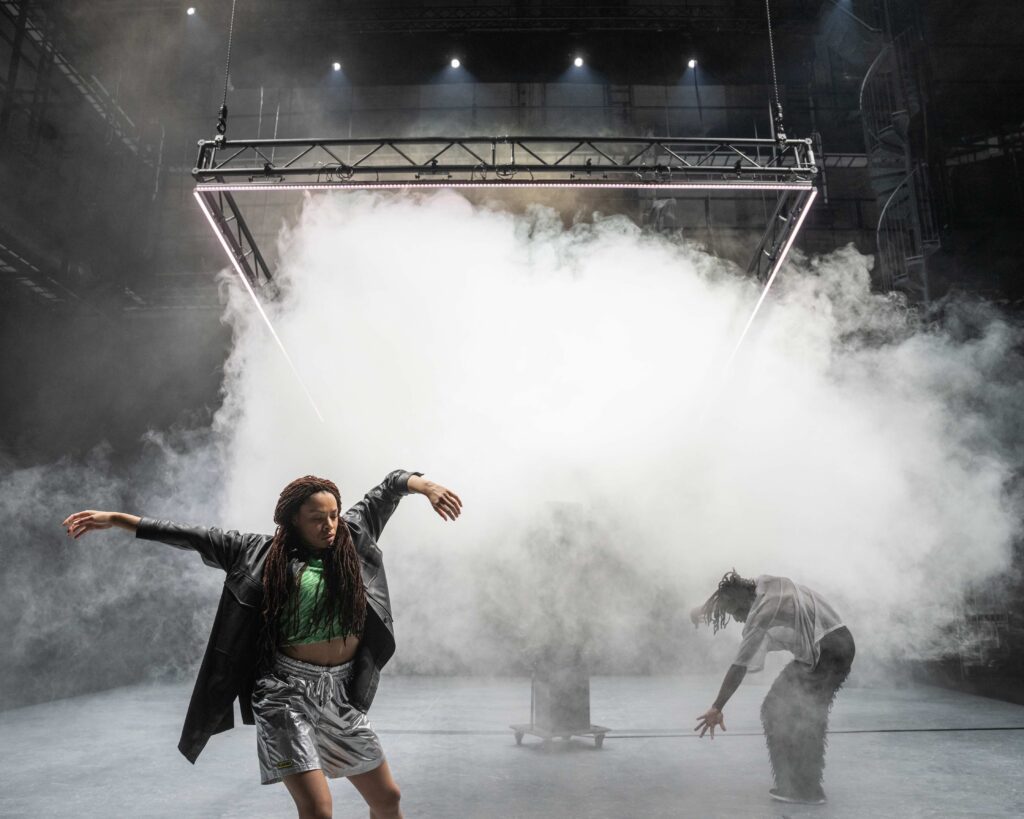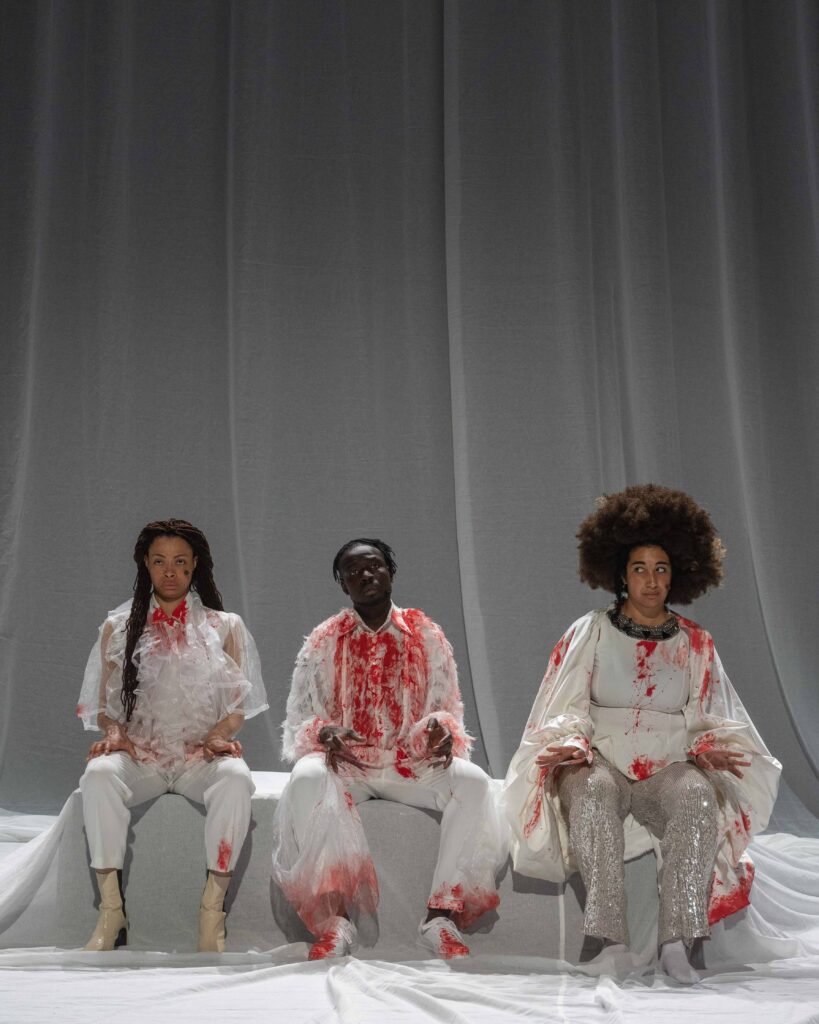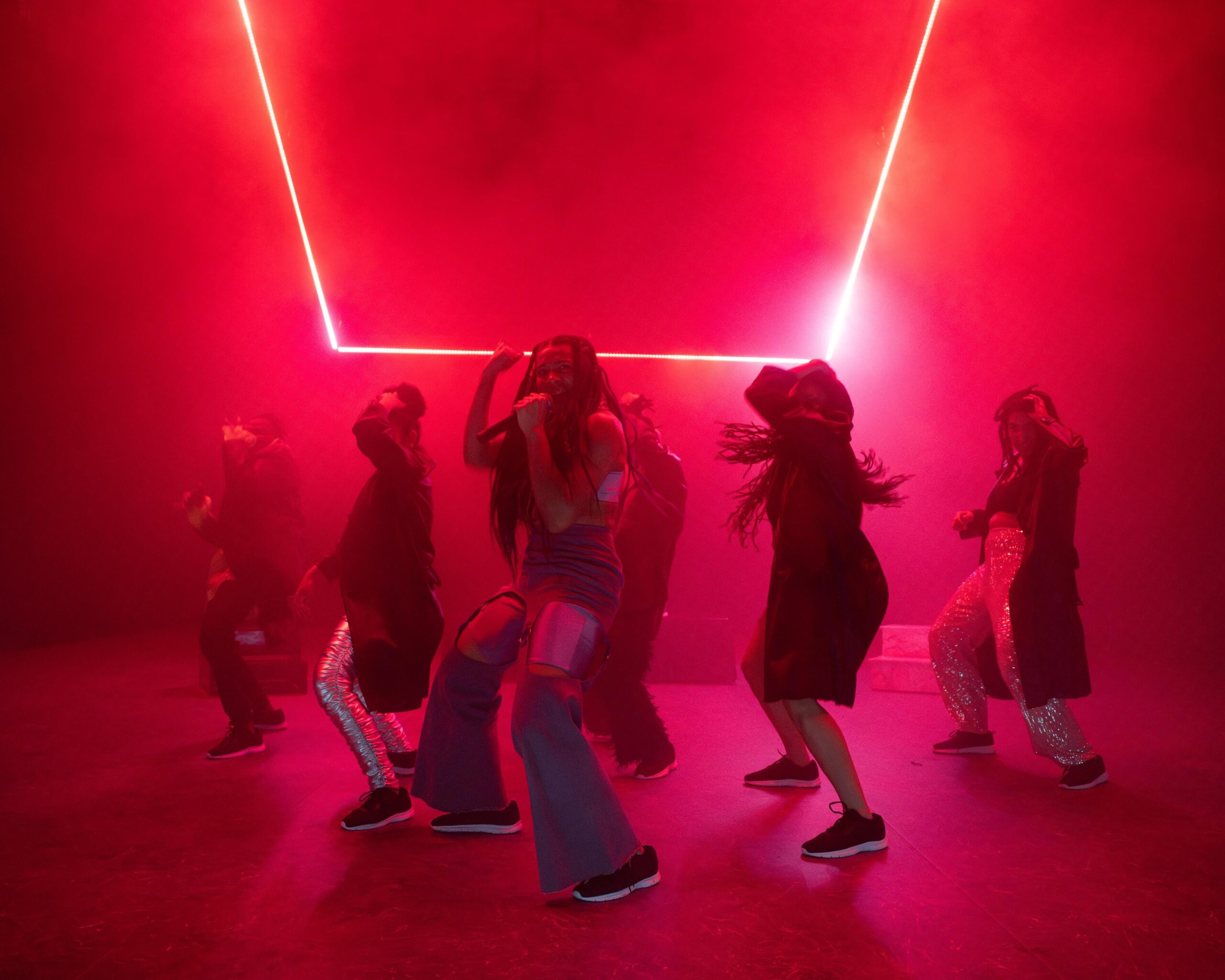Filip Vest reports from ICE HOT in Oslo, reflecting on their experience of watching the performance One Drop by Sonya Lindfors, a decolonial tour-de-force and mix between dance, operetta, talk show and sitcom.
Flicking through the program of this year’s ICE HOT festival, I knew I wanted to see One Drop by Sonya Lindfors, but I didn’t know what to expect at all. The description had a mysterious feel to it that I was really drawn to, promising a “speculative summoning of a decolonial dream, an autopsy of the Western stage and an operetta”(!) The inspiration for One Drop comes from the reggae ‘one drop’ beat as well as the one-drop rule’ of the Race Separation Act from the United States in the early 20th century, that stated that a single drop of “Black blood” made a person “Black”. The piece lasted two hours and was a rollercoaster of a show. I never knew what was going to happen, where the piece was heading and when it would end (if it was ever going to end!). This is my attempt at describing what took place during those two hours, even though I’m still not completely sure…
*
One Drop starts with a very intimate and mundane scene. Two performers are dancing to the reggae track Handsworth Revolution (1978) by Steel Pulse. It feels like the dancers are the last people at a party (or the first), just dancing all by themselves – and for themselves. At one point the dancers are interrupted by another performer that jumps in on the stage as some kind of creature. The creature then proceeds to crawl around on all fours, circling the stage. More performers enter. It no longer feels mundane. Something is off. The performers start moving each other like puppets with invisible strings. Slowly they become more and more machine-like, turning into one body, one machine. They move as if in a trance. Something is building up.
The creature that stopped them earlier, now returns, even more menacing, he’s reaching for one of the other performers with his long nails. He walks towards her with a smirk on his face, breathing heavily and announcing different words in a deep voice, giving off a campy queer villain from musical theatre: “Association. Accumulation. Black exploration. Colonization.” He stops and looks at the audience: “Contemporary operation”.

“Show it don’t tell it”, goes the age-old advice, but One Drop begs to differ, telling us again and again with the camp sentimentality of a school play. The telling itself becomes an act of exorcism, as the words from the campy creature, now turned into a sexy exorcist makes the other performer’s bones crack. She screams as he continues his speech. “Degradation. Globalization. Human relations”, he recites before jumping into Beyoncé’s lyrics: “Okay baby now let’s get in formation.” It’s a weird, uncomfortable mix of violence and tongue-in-cheek humor. Finally, the queer villain-creature-exorcist is defeated by a coughing spell.
The following scene is in complete contrast to the exorcism – the telling. Here words are sung backwards in the form of an operetta, while one performer dances in a gold sequin dress. It feels hopeful and unclear, like a poem.
Then follows a series of choreographies where the performers turn into a group of students looking at a statue, then a military school in training doing synchronized walks, yelling, and then finally we’re back at an intimate party-situation. Two performers are the only one left on the stage, holding each other in an embrace as it gets darker and darker. And then blackout.

But the piece is not over. In the furthest back of the audience seating, there’s a performer hiding. “Uhhhuuuhhhhh”, she says, like a child, trying to make the sound of a ghost. “Bring my light over here”, the ghost says. Then she starts beatboxing and interacting with the audience, asking them about their zodiac signs, bantering with them. “Today I feel like a black artist entering the white institution”, she announces while she’s almost falling down the stairs. At this point the piece gets completely deconstructed and turns into a form of lecture. The performer starts talking about the prices of tickets and what kind of people that can get access to these spaces. She puts on a cape and performs a monologue from Dracula. Then she gathers donations from the audience, has a little talk show moment with another performer, before announcing: “We will now continue the show”.
This is the dizzying, disorientating motor of One Drop. You never know what to expect. In one of the next sequences two performers start singing a tender rendition of Bob Marley’s Could You Be Loved before going into a version of Tainted Love, where the word ‘love’ has been changed for ‘blood’, allowing for the new lyrics: “The blood we share seems to go nowhere,” and the on-the-nose chorus hinting back at One Drop’s Race Seperation Act premise: “Tainted blood (oh-oh-oh-oh). Tainted blood!” A white curtain drops in what turns out to be yet another fake ending. Now all the scenography gets covered in white fabric, as objects that need protection or renovation, or have just been forgotten or hidden away. Then follows another operetta-sequence, this time in a blood-stained dress.
At this point the piece transforms into what feels like a scene from a sitcom. A friend group consisting of vampires are sitting in a couch. “You look like you’ve seen a ghost,” one of them says. “Low blood sugar,” another jokes. Then the vampires turn into / turn out to be colonialists and begin discussing how they should divide Africa between them. They then make a list of colonial products. “You are what you eat,” one of them says. Another is afraid that his blood might be tainted. He’s asking, “for a friend”, he ensures them. It leads to a discussion about purity – and individualism – as a fantasy. And in this way One Drop layers more and more images on top of each other, joking and punning and being gravely serious at the same time.
Eventually, some of the vampires turn into directors and actors, rehearsing for a play. “If this scene was written by Black artists, what would you say?” the director asks, and the actor tries a new solution, echoing some of the methods made popular in the 70s by the Brazilian theatre practitioner Augusto Boal’s ‘Theatre of the Oppressed’, where new solutions to real life struggles and power dynamics were LARP’ed (a live action role playing game in which a group of people enacts a fictional scenario) into being together with the involved parts.

With its infinite twists and series of false endings One Drop feels like it never ends – like the legacy of colonialism, never ends. “What if the colonizer understood the consequences of their actions and everything fell apart?” one performer asks. And after two hours, we do get an ending as we’re left with the image of a rubble, the remains of our society being investigated by a group of future archeologists.
One Drop is messy. it’s all over the place. It’s doing all the things you’re not supposed to. But it’s also taking the mess seriously, insisting on it, while also providing care for each sequence of the piece (that almost feel like a dozen performances in one). The performance is a breath of fresh air in a Scandinavian dance scene, that is so minimalist and conceptual (and white). It’s a work that is equal parts heartfelt and ironic, entertaining, and annoying (in all the good ways), very clever and incredibly stupid.
Lindfors’ piece is also a reminder that minimalism is a colonial ideal. “What happens if we try to stay with the mess?” the piece seems to ask. And it makes me think that if we’re going to imagine a new world, we will have to do several things at the same time. We will be too much. We will be misunderstood. We will fail and fail again. We will think that it’s over. But the ghosts of the past will keep showing their faces, the vampires will never die. We will have to fight the intertwined monsters of capitalism and colonialism. And we will have to face the monsters in ourselves.
